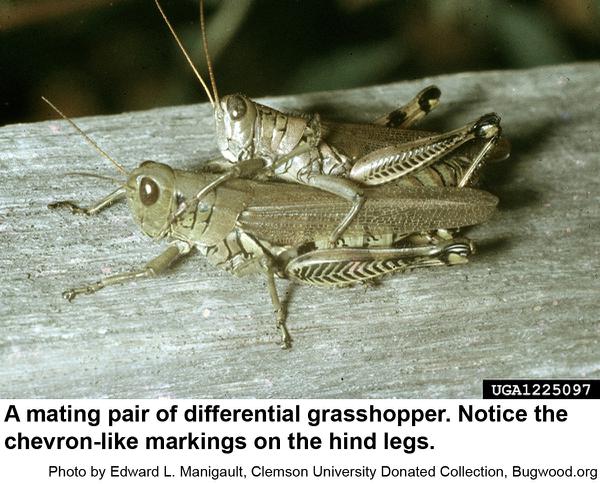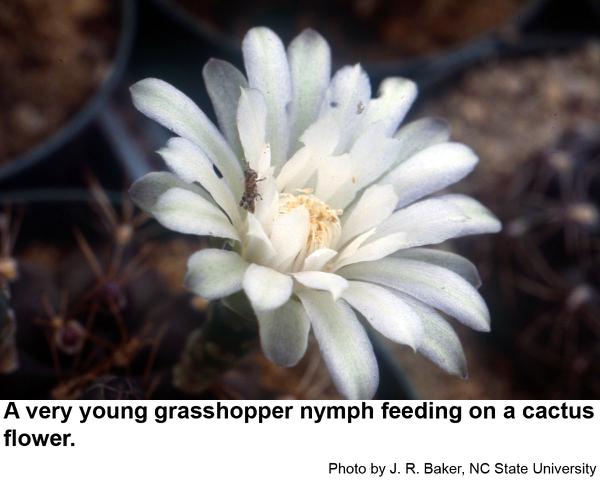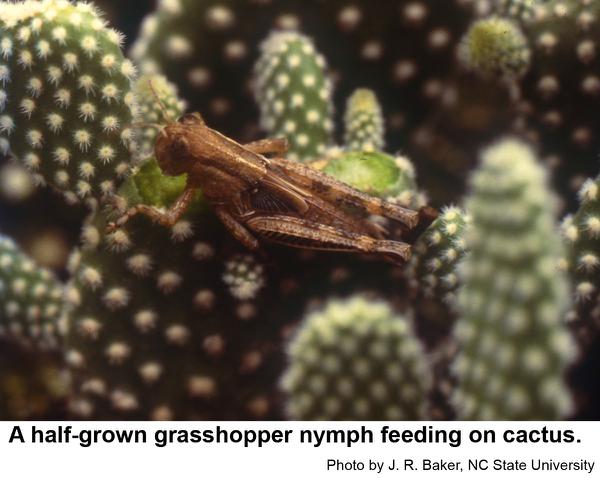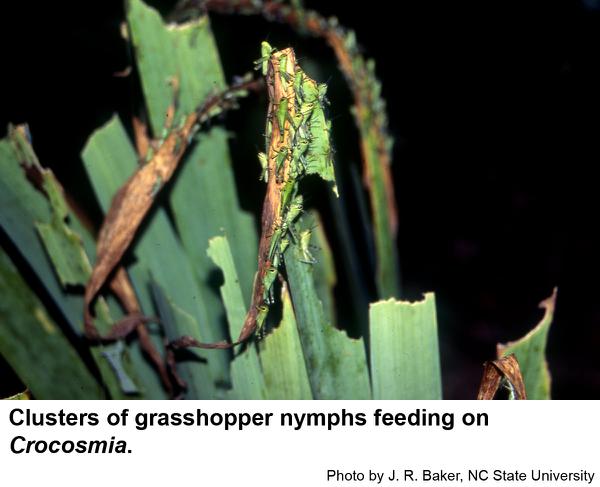Description and Biology
Grasshoppers usually have stiff, leathery wings and hind legs adapted for jumping. Most of our species are 3/4 to 11/2 inches long. The differential grasshopper, Melanoplus differentialis, is yellowish to olive green with black markings and black chevrons on the hind femur (thickest segment). Redlegged grasshoppers, Melanoplus femurrubrum, are reddish-brown with yellow undersides and red hind legs. The twostriped grasshopper, Melanoplus bivittatus, is greenish yellow with black and brown markings and two pale stripes from the head to the tip of the wings. Grasshoppers jump and fly readily, except for the eastern lubber grasshopper, Romalea microptera. This latter grasshopper is remarkable for its size (almost 3 inches) and bulk. Handle eastern lubber grasshoppers with care as they can expel a very irritating fluid up to 6 inches! After mating, females lay their eggs by inserting the abdomen into the soil and laying their eggs in a slender mass 25 to 150 eggs surrounded by a glue-like secretion. The eggs resemble grains of rice surrounded by a pod. When first hatched, nymphs are white but soon darken with markings that resemble those of their parents. Nymphs are wingless but develop wing "buds" as they grow and molt. Young nymphs may feed in clusters before dispersing. In 35 to 50 days, nymphs finally molt into the adult stage. After feeding for about two weeks, females are ready to lay eggs. Our grasshopper have one or two generations per year. Dry weather tends to allow grasshopper populations to increase, but populations of blister beetles may build up the next year because the larvae of blister beetles feed in the egg masses of grasshoppers. Parasitic flies and nematodes also infect grasshoppers.
Grasshoppers are closely related to the locusts of the Old World that sometimes swarm in astronomical numbers across vast areas wreaking havoc on vegetation. In the western United States back in the 1800's, farmers endured plagues of grasshoppers of Biblical proportions. A former member of the Department, Dr. Charles Brett, studied the question of why our grasshoppers no longer swarm. His conclusion was that alfalfa has some sort of growth regulator effect on developing grasshoppers. As more and more alfalfa was planted across the western US, our grasshoppers stopped swarming.
Host Plants
Grasshoppers feed on a wide variety of field crops, vegetables, and ornamental plants ranging from cactus to Crocosmia.
Residential Recommendations
Sevin and other insecticides are labeled for grasshopper control. Fortunately, grasshoppers are not resistant to pesticides, although once the population builds up to the point where pesticides application is needed, it may take several applications at two or three day intervals because of migration in from nearby areas. Most insecticides labeled for residential landscape use will provide more than adequate control.
References
- Common name: eastern lubber grasshopper, scientific name: Romalea microptera (Palisot de Beauvois) (Insecta: Orthoptera: Romaleidae). Capinera, J. and C. Scherer. 2016 (revised). Featured Creatures. Entomology & Nematology, FDACS/DPI, EDIS. Publication Number: EENY-6.
- Insect and related pests of vegetables. Sorensen, K. A. and J. R. Baker eds. 1994. North Carolina Agricultural Extension Service publication AG-295. 180 pp.
- Extension Plant Pathology Publications and Factsheets
- Horticultural Science Publications
- North Carolina Agricultural Chemicals Manual
For assistance with a specific problem, contact your local N.C. Cooperative Extension Center.
This Factsheet has not been peer reviewed.
Publication date: Jan. 22, 2018
Reviewed/Revised: Nov. 4, 2022
Recommendations for the use of agricultural chemicals are included in this publication as a convenience to the reader. The use of brand names and any mention or listing of commercial products or services in this publication does not imply endorsement by NC State University or N.C. A&T State University nor discrimination against similar products or services not mentioned. Individuals who use agricultural chemicals are responsible for ensuring that the intended use complies with current regulations and conforms to the product label. Be sure to obtain current information about usage regulations and examine a current product label before applying any chemical. For assistance, contact your local N.C. Cooperative Extension county center.
N.C. Cooperative Extension prohibits discrimination and harassment regardless of age, color, disability, family and marital status, gender identity, national origin, political beliefs, race, religion, sex (including pregnancy), sexual orientation and veteran status.




